|
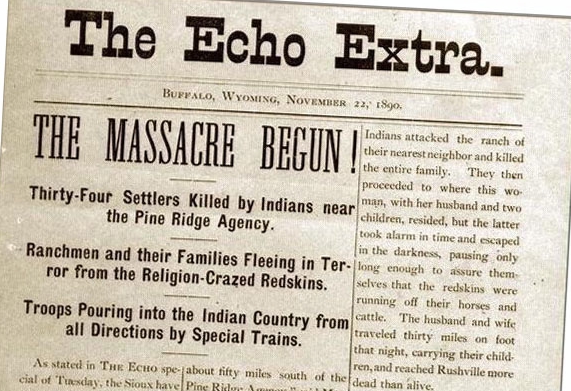
Special Edition Buffalo Echo, November 22, 1890
Not withstanding the death of Crazy Horse and the confinement of Indians to
reservations, fear of the Indians continued as late as the 1890's. The Buffalo Echo joined
the histeria which swept parts of the west in 1890 relating to the "Ghost Dance." On
November 22, 1890, the paper put out a extra edition reporting under the headline, "THE
MASSACRE BEGUN," that "religion crazed Redskins" had broken out of the Pine
Ridge Agency. The paper reported that 20,000 troops were being called up and that
Fort Robinson had been left unprotected. It further reported that ranchmen and
their families were "fleeing in terror." The entire issue was based on conversations with
a lady who was passing through by stage and who had no first hand knowledge, but
was merely repeating what she had heard.
Buffalo was, however, not the only place to be gripped by fear of an Indian uprising. In
Newcastle, the Kilpatrick Brothers & Collins Commissary (later the Antlers Hotel) was fortified and
stocked with guns and ammunition. The windows were barracaded with sacks of flour. A ladder
was constructed so as to provide access to the roof from which the defenders could fire upon
the Indians' expected attack.
The panic had commenced with an article in the Rapid City Journal of November 20, 1890,
which had reported that the Sioux were on the warpath. As a result, in
December, the governor of South Dakota activated the South Dakota Home Guard which
proceeded to kill and scalp 75 ghost dancers.
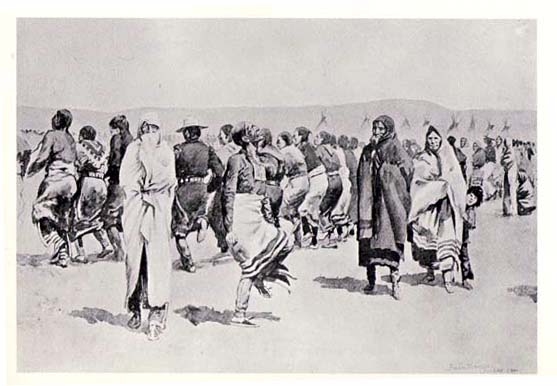
Ghost Dance of the Oglala Sioux, Frederic Remington, Harper's Weekly, December 1890.
Since the days of the pharaohs, an eclipse of the sun has been deemed to have mystic powers. It has
been contended, as an example, that an eclipse in 1351, B.C. inspired the Pharaoh Amenhotep IV (1356-1340 B.C.) to adopt
the religion of Aten. On January 1, 1889, a total eclipse of the sun was visible in the Western United States. In California, the
day dawned cloudy and overcast. Father Charles Marie Charroppin, nevertheless, predicted that the
Virgin Mary would part the clouds. As the eclipse neared totality, the clouds parted to a perfectly clear sky. In parts
of the Islamic World, the Hadj was cancelled. Later that year, Mark Twain published his
Connecticut Yankee in King Arthur's Court in which a central plot device was a
total eclipse of the sun. And in Nevada, Wovoka (1856-1932), a Paiute Indian son of Tavibo an Indian mystic,
in the early morning hours prior to the eclipse fell unconscious from scarlet fever. As the eclipse passed, he awakened as if from
the dead and described how during the eclipse he ascended to Heaven and communed with the Great Spirit.
The Great Spirit revealed that there would be a great flood which would wash
the world of all corruption and there would be a Second Coming of the Messiah who would take the form of an Indian. If the
Indians would become educated, do right, not fight, be truthful, abstain
from alcohol, and dance and sing in prayer, there would be peace and harmony among all
men, the buffalo would return, there would be the resurrection of the dead,
and His children would become prosperous. Soon word of the new
religion spread among the Indian tribes of the west.
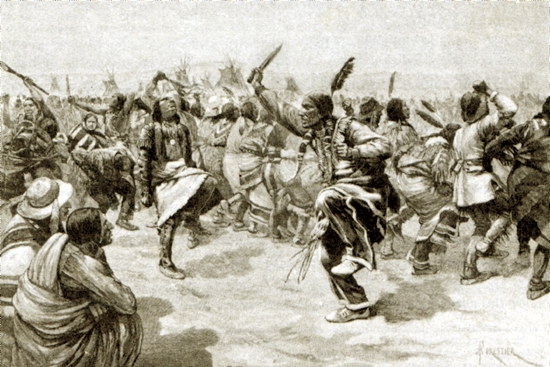
"The Ghost Dance of the Sioux Indians in
North America," Illustrated London News, woodcut based on sketch by Amédée Forestier, 1891.
Amédée Forestier (1861-1930) was an illustrator for the Illustrated London
News, but is most famous for his 1922 illustration of "Nebraska Man,"
Hesperopithecus heroldcookii, and an earlier rendering of Piltdown Man. See Note at bottom of page.
With each tribe variations appeared. In the Wind River of Wyoming, the
Arapaho rejected the new religion. With some Shoshoni, the religion partook of some elements of
the old sundance and Episcopal teachings and the dance would be around a
decorated cedar tree, emblematic of everlasting life. In others, the Indians would dance themselves into exhaustion and collapse in
a trance. In the trance, the Indians would receive messages from the Great Spririt or would visit
with deceased relatives. In some tribes, following the dance, the Indians would
retire to a river and be immersed and washed of their sins. The Sioux sent a delegation to Nevada and brought the
teachings back to Pine Ridge, much to the alarm of Gen. Miles in Chicago. Among some Sioux, it was believed that
the robe worn while dancing would provide immunity to the white man's bullets. Among those who promoted
the new religion was Sitting Bull. Thus, the order went forth for the arrest of Sitting Bull as the
new religion was contrary to the official policy promoting Christianity among the
Indians.
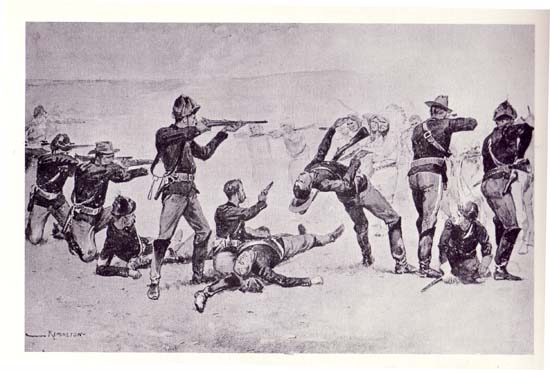
Opening of the Battle of Wounded Knee, Frederic Remington, Harper's
Weekly, January 1891.
On December 15, 1890, Sitting Bull was
killed by Indian police as they attempted to take him into custody. Some of the Sioux then fled in fear, with about 100 joining
Chief Big Foot on the Cheyenne River. Chief Big Foot, suffering from pneumonia and coughing up
blood which would then freeze in the snow, sought to lead his
tattered band of aproximately 120 men and 230 woman and children to the agency
at Pine Ridge.
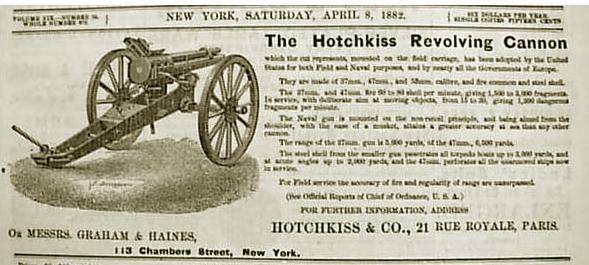
Advertisment for Hotchkiss Revolving Cannon,
Army Navy Journal
On December 28, the band met up with the Seventh Cavalry which surrounded it, and sought to
disarm the Indians. One Indian, Black Coyote who was deaf, did not wish to surrender
his Winchester. In an ensuing scuffle the rifle discharged wounding an officer. Immediately,
the soldiers opened fire with, among other things, four Hotchkiss rapid fire
machines guns, each capable of firing two-pound, ten-ounce shells at a rate of 50 rounds per
minute with an effective range of 4,200 yards. At the end, between 200 and 350 Indians lay dead in the snow, including
women and children who were two miles from the scene.

Chief Big Foot, Wounded Knee
Among the dead was
Chief Big Foot who had a white flag next to his tent. Twenty-five troopers were also killed,
most by their own cross-fire. On New Year's Day, troops were sent out to recover
the dead. Beneath the snow next to her dead mother, a baby was found still alive, swaddled in a blanket,
and upon her head a deerskin cap with a beadwork American flag. The dead were left in the snow for over a week and
then buried unceremoniously in a mass grave.
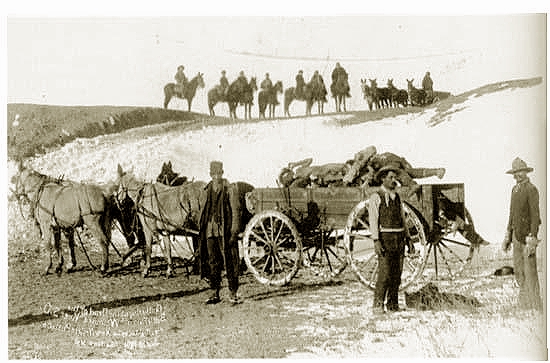
Frozen bodies being removed at Wounded Knee.
The Seventh Cavalry received for its
gallantry twenty Congressional Medals of Honor. One hundred years later the
Wall Street Journal continued to refer to the massacre as the "Battle of
Wounded Knee." One of the grievances of the American Indian is that when the
Indians won, it is referred to as a "massacre," i.e. the "Fetterman Massacre." When the
cavalry defeats even unarmed Indians or Indians under a flag of truce, i. e. Sand Creek
or Wounded Knee, it is a "battle."
NEBRASKA MAN

Nebraska Man, Illustrated London News, woodcut based on sketch by Amédée Forestier, 1922.
In 1922, Sir Grafton Elliot Smith disclosed the startling news that the remains of an early
man, possibly the "missing link," had been discovered five years before in the
Agate Fossil Deposits of Nebraska, some 55 miles southeast of Lusk, Wyoming, along the
Niobrara River. The remains had been
discoverd by Harold Cook. Inititially the remains were dated to the Pliocene
Epoch 2.3 to 5.3 million years before the current time. Later investigation has revealed that the deposits date to the
Niocene Epoch 5.3 to 23.8 years before the current time. The Agate Fossil deposits
are now protected by National Monument status and are regarded as one of the
foremost deposits of mammalian remains in the United States. Indians have
resided in the area for the past 11,000 years.
Sir Grafton was one of
the scientists who confirmed the authenticity of the discovery of Piltdown Man in 1912.
Forestier, himself, had acquired some renown as the artist who provided a
visual reconstruction of Piltdown Man and was regarded by Sir Grafton as one of the
foremost illustrators of hominoids. With the invention of fluorine testing in 1953,
Piltdown Man was discovered to be an elaborate hoax, consisting of a conbination of
a human skull and orangutan jaw which had been chemically treated to give an
appearance of age. None the less, there has been no question as to the age of
the Nebraska Man remains. Further investigation and the discovery of further
remains has confirmed that the remains are, indeed, from the Niocene Epoch. The only
difficulty is that the remains discovered by Cook consisted of a single tooth from which the artistic
reconstruction had been made by Forestier with the assistance of Sir Grafton. And the
tooth after further investigation turned out to be that of a Niocene pig. Thus ended
the saga of the first Cornhusker.
|
Next page: Building the Pacific Railroad.
|